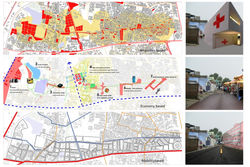 History and Evolution |  Observations: Site Study |
|---|---|
 Macro Scale Layers |  Macro scale Layers |
 Drivers for Transformation |  Livability |
 Economy |  Human Scale |
 Stakeholders analysis |  Sarkhej Axis- Layers |
 Simulations |  Simulations |
 Existing Master Plan |  Proposed Master Plan |
 Sarkhej: Area level analysis |  Area level Strategies and Guidelines |
 Defining Scope of Project |  Reviving the Historic Axis |
 Existing Scenario |  Current Issues |
 Proposed Scenario |  Proposed Scenario |
 Guidelines |  Guidelines |
 Existing View |  Proposed view after transformation |
Urban Transformation
Asia’s largest Muslim ghetto: Juhapura, and Sarkhej precinct, Ahmedabad.
Studio III
The art of urbansim is a constant negotiation between personal biases and socio-political realities, and the cities are complex repositiories of complex decisions, whims and choices all in a constant flux.
The studio revolved around the question that- How Urban Design can be transformative by bieng more inclusive
and focused to create initiatives that contribute to the economic progress and/or environmental sustainability of the low-income individuals and the community. It was important to look at -who are the end users?, What are their issues?, How to deal with the on-ground reality?
Instead of through sudden, top-down decisions that do not account for consultations with citizens and largely ignore the population’s leanings, The studio primarily involved the stakeholders of the area and study their views and concerns